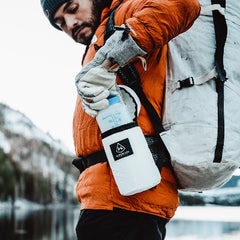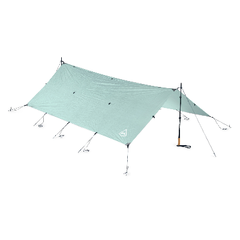Words by Taylor Bracher // Photos & Video by Taylor Bracher & Emily Sullivan, on Ahtna and Upper Tanana Athabascan Lands
“Holy!... Shit!” Emily yells out in short spurts between deep breaths. “It’s just as bad as I remember!” It is too difficult to discern if she’s laughing or crying. Probably both.
We walk across the icy open waters of the Nizina River, with our pants rolled up above our knees and our skis and boots strapped on our packs. I use my skate ski poles to balance as my bare feet try to feel their way over the slick river rocks, but they go numb before I finish the crossing. My shin bleeds when I break through shelf ice on the shore, and my feet protest in pain, a thousand tiny daggers stabbing them as we haphazardly try to dry off and get back in our ski boots. We need to get moving- to warm back up and because we have so much more ground to cover, and more open water ahead. This is the Alaska Mountain Wilderness Ski Classic, and these river crossings are all too familiar.

Last March, we were in the same spot in the same event, trying to ski over two mountain ranges from McCarthy to Log Cabin Wilderness Lodge near Tok (160+ miles). But after heavy rain, unprecedented early river breakup, and red flag avalanche conditions, all participants of the 2019 AMWSC turned around on the second day. The horrendous conditions and abrupt end to a highly anticipated experience were a huge let down for most of us, and Emily and I promised each other we would seek out more fun and less suffering on a spring adventure in 2020. Preferably a trip with fat powder skis and steep lines, instead of long days, skinny skis, heavy packs, and open river crossings.
So why are we here a year later, doing the very thing we swore we wouldn’t? This is a question we ask ourselves many times as we inch our way across the glaciers and rivers of the Wrangell Mountains.

Each morning, I shoulder my forty-pound pack, and my feet protest in my plastic ski boots, while my hips blister where my glacier harness and pack overlap. To maximize efficiency, we take breaks while standing up and keep food, water, and sunscreen accessible while moving. We encounter very slow trail-breaking through sugar snow and have a route-finding snafu that sets us back. The days are hot as the sun reflects off the snow, but there is a disturbance in the weather headed our way. We feel the pressure to make miles as we slowly fall behind our intended schedule.
On our third day, we navigate the heavily crevassed Whiskey Hill without issue but don’t make our pass below the President's Chair before dark. We set up camp at approximately 7,200’ and build wind walls around our tent in anticipation of the incoming storm. Once we stop skiing, our boot liners, wet from days of sweat, freeze solid while our feet are still inside them. We’re hungry. We’re dehydrated. Neither of us has gotten much sleep. The wind picks up.
I look to Emily, who is eating her dinner inside her sleeping bag, and say, “Promise me that, no matter what I say after this, you won’t let me do this again.”
“Oh yeah, I promise.” “No way,” she replies. We are in agreement.
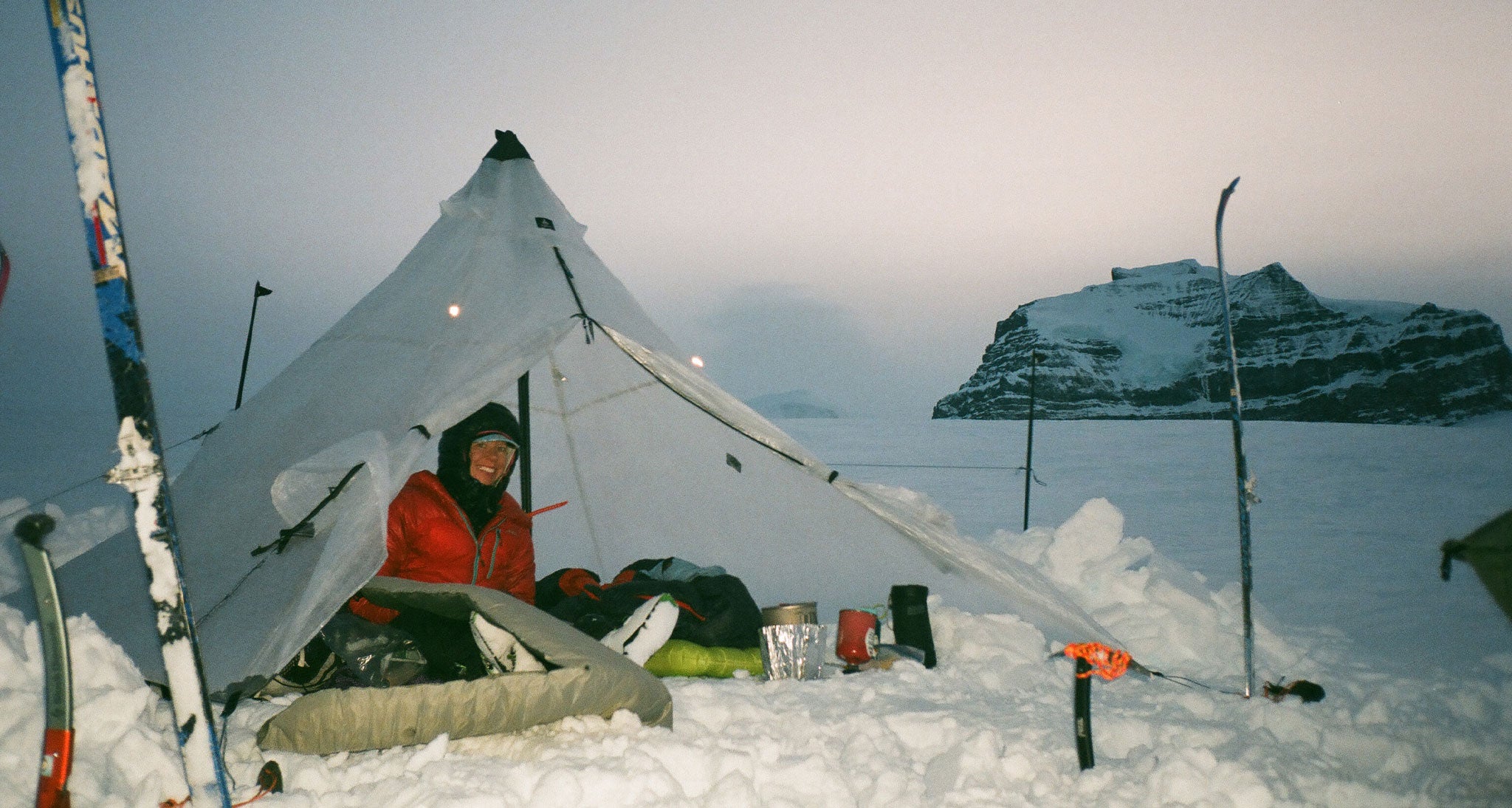
In the morning, I pop out of the tent, and wind pelts snow onto my face. I squint but I am unable to see the hill we’re camped on, much less the huge crevasses between us and our 8,300’ pass below the President’s Chair. Last night, Emily received a weather forecast on her inReach that suggests this storm will be short-lived, but intense. We wait. I don’t know what is louder, the tent flapping in the wind, or my stomach growling. I ration my food, knowing I should save the calories for when I’m moving.
By mid-day, we have enough visibility to feel comfortable packing up and making forward progress. I stuff my frozen boot liners back in their shells, and force my feet inside, a laborious process that involves lots of grunting and cursing. The visibility is in and out, and travel is slow going. We inch forward when we can see, then wait as clouds move back in. Inch forward, then wait. Finally, after lots of patience and navigating by GPS, we strap our skis to our backpacks, hop over a bergschrund, and boot pack over icy rocks to the pass.
I jab my skate ski poles into the rime and joke, “I love Nordic skiing!”
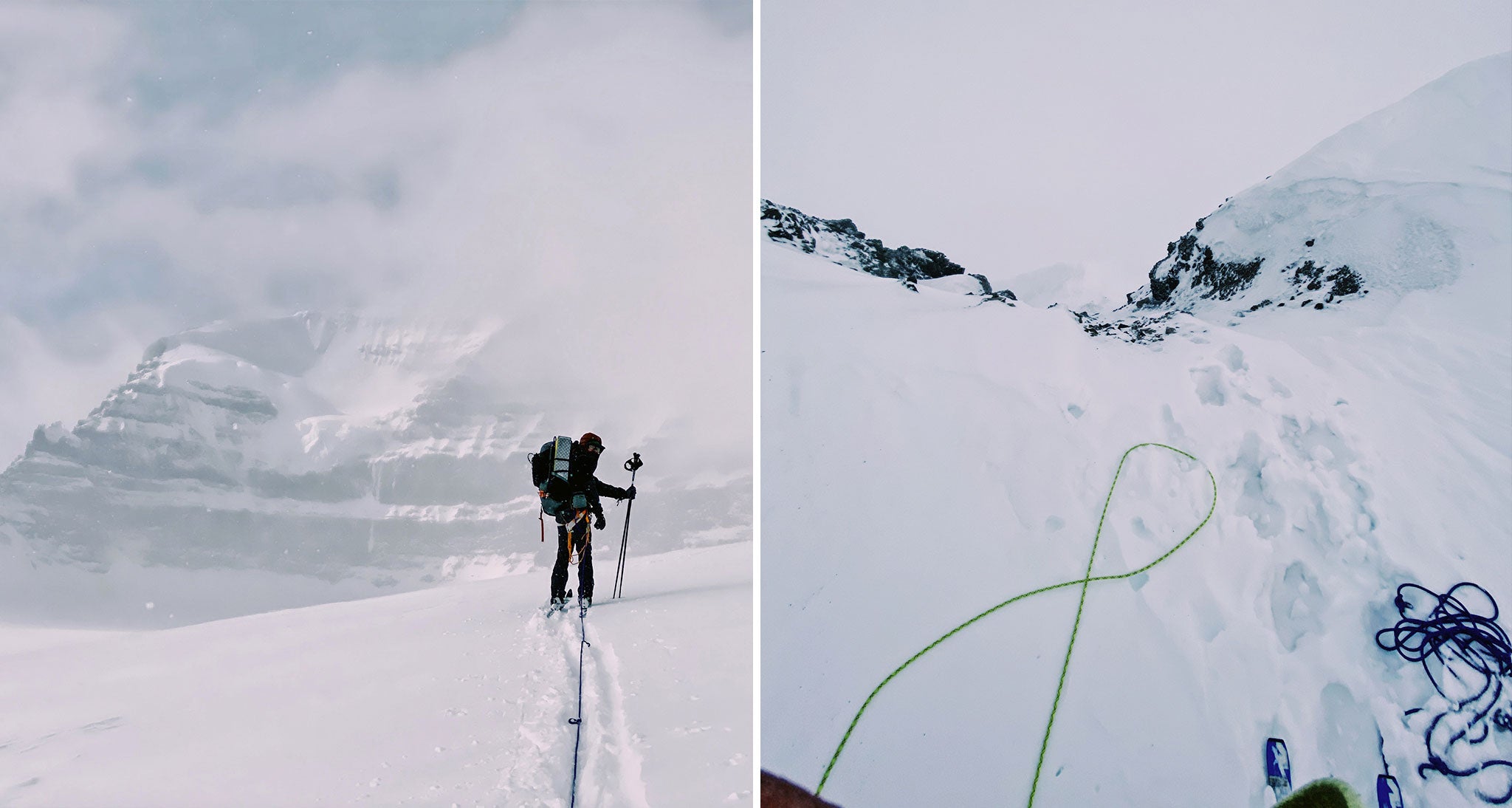
We quickly drop onto the other side of the pass, and the views open up, revealing dramatic peaks all around us. Light, fluffy snow falls out of a cloudless sky like glitter. We power-wedge downhill, still roped up, through a couple of inches of sparkle powder.
“Emily! What are we doing!?” She knows what I’m asking.
“Skinning downhill! Roped up! Through fresh snow! On Nordic skis!” she replies.
“The Wilderness Classic!!!” I shout.
Soon, we drop the rope and rip skins. We double-pole down the glacier through the new snow, shimmering in the March sunshine. The sun kisses our cheeks, and Emily, and I leave behind the stress of the previous days. We strap our sleeping bags to the outside of our backpacks to let them dry out while we ski. It’s not long before one of us giggles and says, “I’m having fun!”
“Me too!”
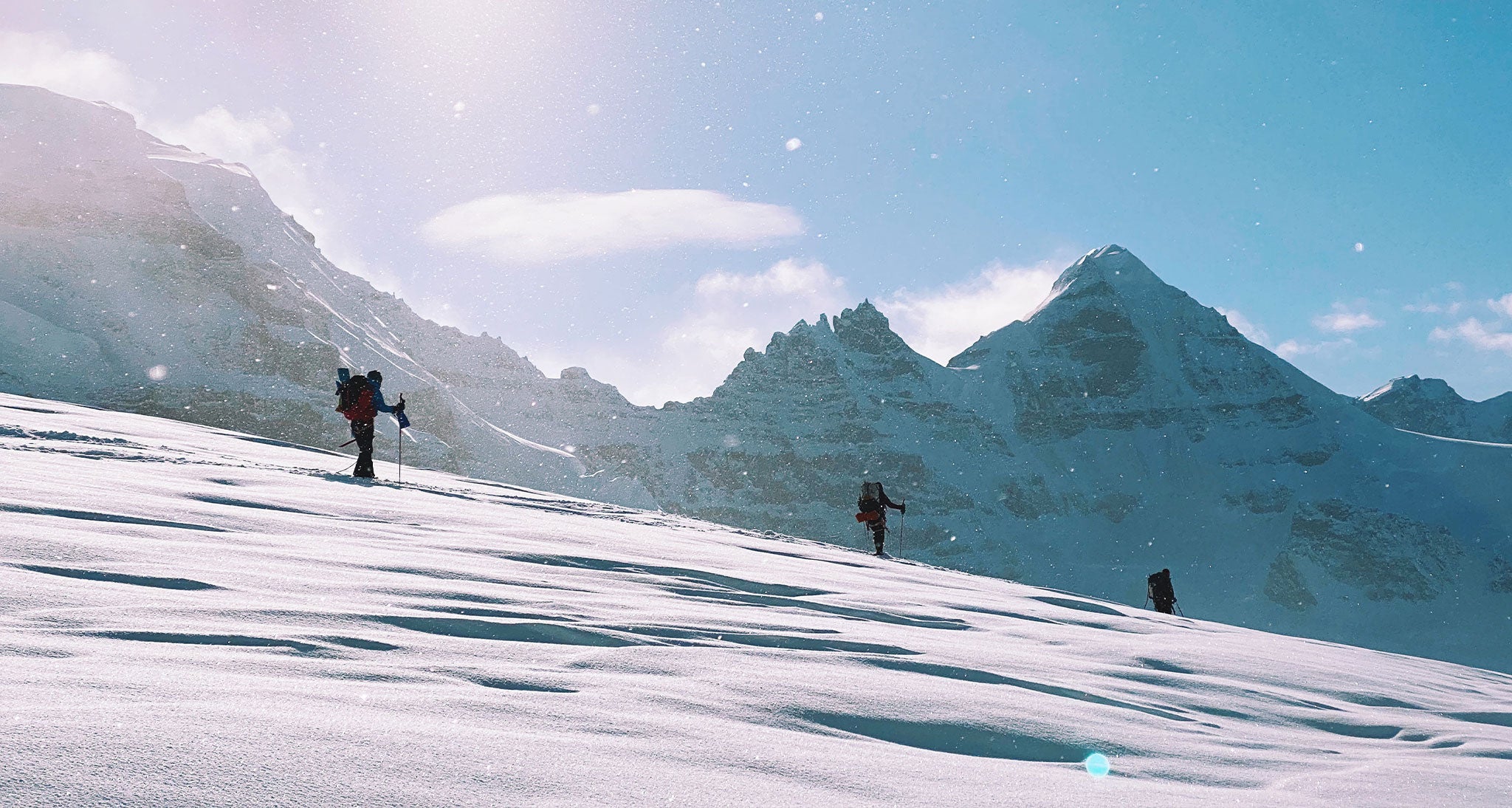
Fading Affect Bias (F.A.B.) is the phenomenon where positive experiences retain emotional intensity, while negative memories fade much faster. When reflecting on our backcountry adventures, we tend to let go of memories of the heinous terrain, our suffering feet, or brutal weather, and hold on to the feelings of accomplishment from a summit, the glow of a sunrise, or the excitement of wolverine tracks in the snow. It has also been shown that over time, events that were perceived as negative at the moment can ultimately come to prompt positive emotions upon recall. Our brains can trick us into remembering things in a better light.
Emily and I enjoy the brief relief on the Sparkle Glacier but getting over the President’s Chair pass was only the first of two major hurdles on our route, and what lies ahead is arguably a much greater challenge. The Nabesna Glacier, fed from the icefield on Mount Wrangell, is the longest interior valley glacier in the world. And we have to cross it.
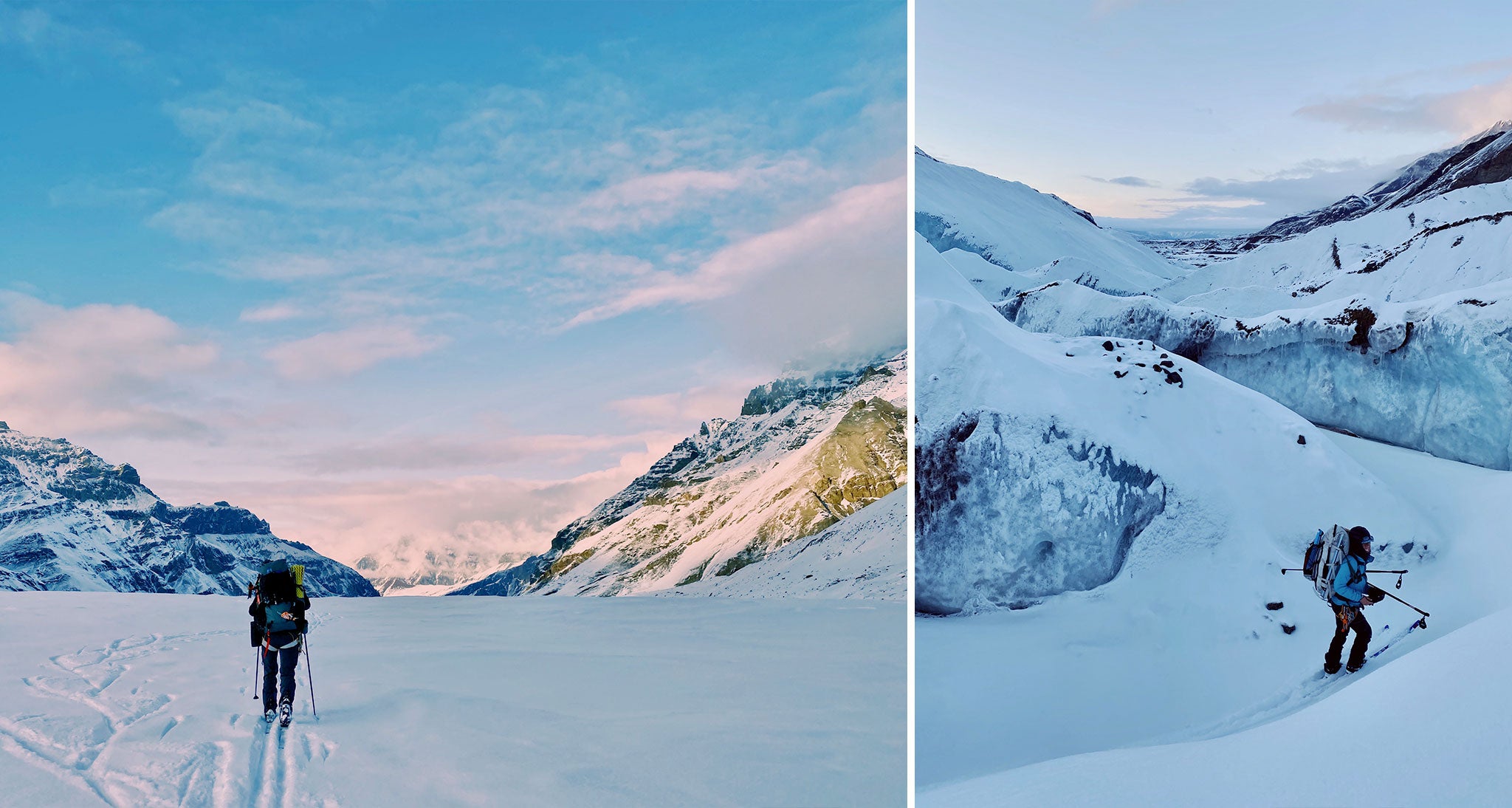
We were given useful directions from those who have traveled this route before about how to get across and down the Nabesna’s massive crevasses and rugged moraine, but once on the edge of the glacier, Emily and I know that not even the most detailed instructions can adequately describe what we got ourselves into. We look across a sea of ice and rock. Waves of blue seem flash-frozen in time, and we slowly pick our way across their crests. The new snow from the previous day’s storm still clings to the glacier, obscuring the distinction between solid blue ice and crevasses filled with old snow. Our metal ski edges scrape the ice bare whenever our skis slip out from under our feet. We switch to crampons, and I almost immediately put a leg in a crevasse.
Emily and I stand together, as frozen as the ice beneath our feet, fully aware that the only way forward is across. “We just have to do it.”
At this moment, a team of three we had been leap-frogging with for the whole trip catches up to us on the glacier’s edge. We all agree that there is safety in numbers, and the five of us navigate the three-mile crossing of the Nabesna together, followed by about ten more miles of descent on the ice to the toe of the glacier. It is very tedious travel, requiring switching back-and-forth between skis and crampons, backtracking and weaving, and some very gripped skiing down blue ice between crevasses.
“I’d probably be fine never coming here again,” I tell Emily.
“This is the glacier of my nightmares,” she replies.
And then we laugh and say, “We love Nordic skiing!”
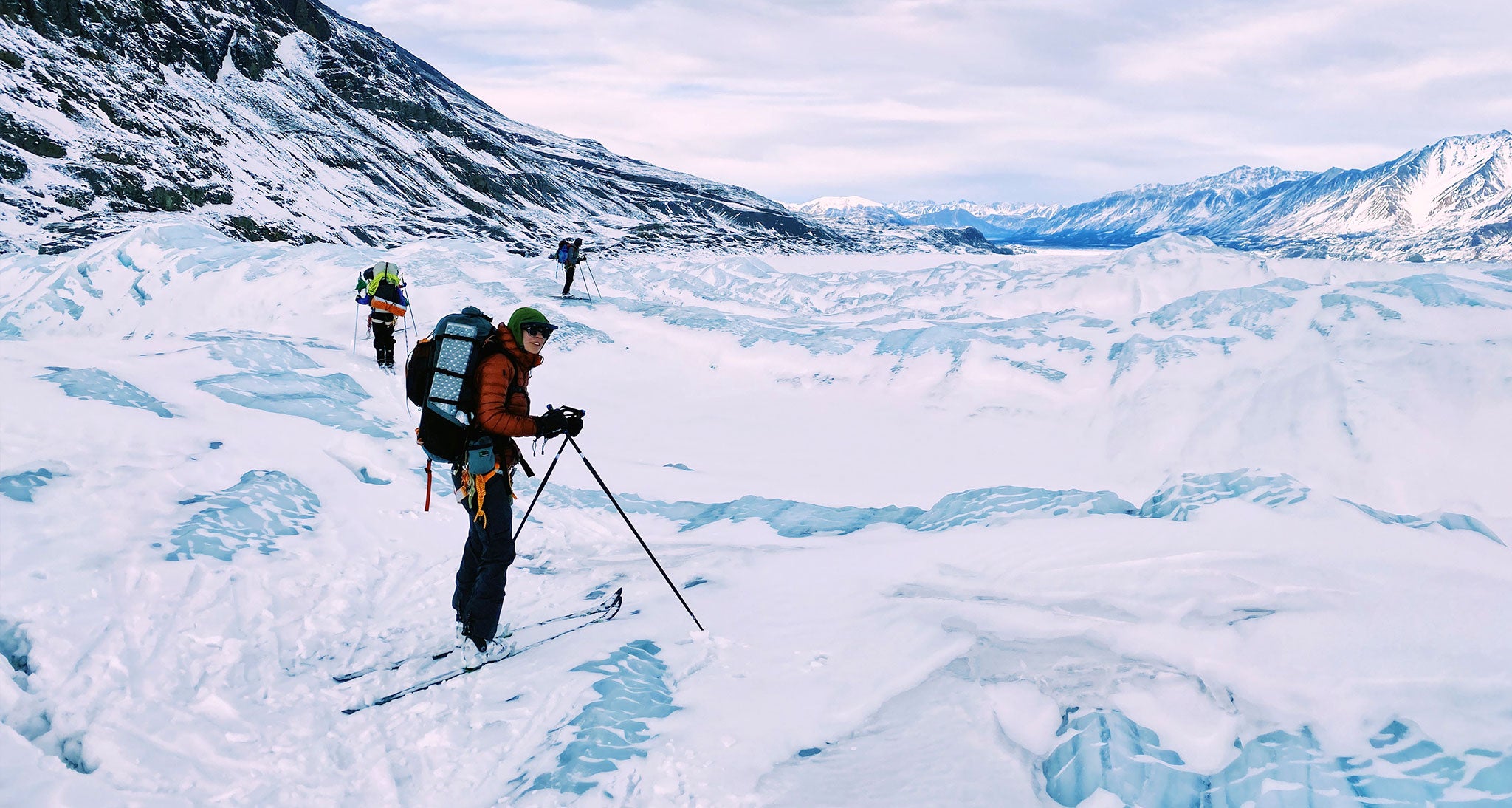
We have to get off the glacier for a short stint, where the Nabesna makes a small icefall as it loses elevation. At dusk, I break trail through bottomless sugar snow and alder bushes while we look for a place to camp. Emily turns on her inReach to ask our friend Eric, who is ahead of us by about a day, for beta about getting back on the glacier in the morning.
Her inReach buzzes and she reads aloud to me, “Very high avy conditions in Noyes area, full burial, all okay. Exit Nabesna Road.” The message is brief, but the instructions clear. Immediately, we are both struck with emotion. A couple tears stream down my face while I bushwhack through the alder.
Six event participants–our friends–took a different way from McCarthy and were ahead of us on the route to Log Cabin, and someone was buried in an avalanche. Emily and I would ski to the small town of Nabesna, cutting our trip short and avoiding the avalanche terrain altogether. After all of the mental and physical stress of everything we had been through so far, now we experience the height of emotional stress. “All okay,” I keep repeating to myself. “They’re all okay.”
Over the course of the evening and the following morning, we piece together where all twelve event participants are in the mountains. Everyone keeps in contact with Dave, the event coordinator, and we all know our respective exit strategies to avoid avalanche terrain. Emily and I still don’t have any other details on the incident, so I continue to remind myself, “All okay.”
The following morning, getting back on the Nabesna Glacier and off at the toe proves really straightforward, and soon Emily and I cruise on the Nabesna River. The river is notorious for a headwind, but the sun is strong, and the wind provides perfect relief from its intensity. We ski past a note written by a ski pole in the snow. “Go Emily Taylor Ben Lindsay Curtis !!!” Left by Eric the day before, it is the perfect morale boost to keep us going and illustrates the camaraderie of this wilderness “race.”

On our final day of the Alaska Mountain Wilderness Ski Classic, Emily and I break trail for thirty miles to Nabesna and make the quickest time of the whole trip. In Nabesna, we will wait for the rest of the crew instructed to exit early, get picked up by Dave (who brings coffee and cookies), and be swept away to Log Cabin Wilderness Lodge, where we will shower and greet the others who ski in from the Tetlin River. A week after starting our trips in McCarthy, we will all be together, safe. Sharing stories, laughter, tears, and hugs.

We take one final break to refill our water bottles at an open lead on the Nabesna River, where we celebrate the feelings of strength, empowerment, and freedom that come from working hard and overcoming more than we thought possible in the mountains. We are both weathered from a week outside, our noses crispy and red from the sun and our dirty hair pasted to our foreheads. Our bodies are hardened from the elements, but our memories of the cracked up Nabesna Glacier already start to soften, and we are having so much fun. I tell Emily that my backpack just feels like part of my body now. She jokes that the blisters on her feet have become old friends. We acknowledge that we’ve found a primal rhythm out here and that navigating the rugged landscape of the Wrangell Mountains feels easier than navigating the “real world” we left behind a week earlier.
Emily tells me, “I know I belong right here.”
I ask, “You wanna do this again next year?”

